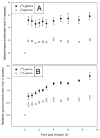Glycine turnover and decarboxylation rate quantified in healthy men and women using primed, constant infusions of [1,2-(13)C2]glycine and [(2)H3]leucine
- PMID: 18029478
- PMCID: PMC5833992
- DOI: 10.1093/jn/137.12.2647
Glycine turnover and decarboxylation rate quantified in healthy men and women using primed, constant infusions of [1,2-(13)C2]glycine and [(2)H3]leucine
Abstract
Glycine plays several roles in human metabolism, e.g. as a 1-carbon donor, in purine synthesis, and as a component of glutathione. Glycine is decarboxylated via the glycine cleavage system (GCS) that yields concurrent generation of a 1-carbon unit as 5,10-methylenetetrahydrofolate (methyleneTHF). Serine hydroxymethyltransferase (SHMT) catalyzes the interconversion of glycine and serine, another 1-carbon donor. The quantitative role of glycine in human 1-carbon metabolism has received little attention. The aim of this protocol was to quantify whole body glycine flux, glycine to serine flux, and rate of glycine cleavage in humans. A primed, constant infusion with 9.26 micromol x kg(-1) x h(-1) [1,2-(13)C2]glycine and 1.87 micromol x kg(-1) x h(-1) [(2)H3]leucine was used to quantify the kinetic behavior of glycine in young, healthy volunteers (n = 5) in a fed state. The isotopic enrichment of infused tracers and metabolic products in plasma, as well as breath (13)CO2 enrichment, were determined for use in kinetic analysis. Serine synthesis by direct conversion from glycine via SHMT occurred at 193 +/- 28 micromol x kg(-1) x h(-1) (mean +/- SEM), which comprised 41% of the 463 +/- 55 micromol x kg(-1) x h(-1) total glycine flux. Nearly one-half (46%) of the glycine-to-serine conversion occurred using GCS-derived methyleneTHF 1-carbon units. Based on breath (13)CO2 measurement, glycine decarboxylation (190 +/- 41 micromol x kg(-1) x h(-1)) accounted for 39 +/- 6% of whole body glycine flux. This study is the first to our knowledge to quantify human glycine cleavage and glycine-to-serine SHMT kinetics. GCS is responsible for a substantial proportion of whole body glycine flux and constitutes a major route for the generation of 1-carbon units.
Figures



Similar articles
-
Moderate dietary vitamin B-6 restriction raises plasma glycine and cystathionine concentrations while minimally affecting the rates of glycine turnover and glycine cleavage in healthy men and women.J Nutr. 2009 Mar;139(3):452-60. doi: 10.3945/jn.108.099184. Epub 2009 Jan 21. J Nutr. 2009. PMID: 19158217 Free PMC article.
-
Production of 1-carbon units from glycine is extensive in healthy men and women.J Nutr. 2009 Apr;139(4):666-71. doi: 10.3945/jn.108.103580. Epub 2009 Feb 25. J Nutr. 2009. PMID: 19244382 Free PMC article.
-
Tracing Metabolic Fate of Mitochondrial Glycine Cleavage System Derived Formate In Vitro and In Vivo.Int J Mol Sci. 2020 Nov 20;21(22):8808. doi: 10.3390/ijms21228808. Int J Mol Sci. 2020. PMID: 33233834 Free PMC article.
-
Genetic manipulation of glycine decarboxylation.J Exp Bot. 2003 Jun;54(387):1523-35. doi: 10.1093/jxb/erg171. Epub 2003 Apr 28. J Exp Bot. 2003. PMID: 12730263 Review.
-
Target enzymes in serine-glycine-one-carbon metabolic pathway for cancer therapy.Int J Cancer. 2023 Jun 15;152(12):2446-2463. doi: 10.1002/ijc.34353. Epub 2022 Nov 30. Int J Cancer. 2023. PMID: 36346117 Review.
Cited by
-
¹³C magnetic resonance spectroscopy detection of changes in serine isotopomers reflects changes in mitochondrial redox status.Magn Reson Med. 2012 Sep;68(3):671-9. doi: 10.1002/mrm.23296. Epub 2011 Dec 21. Magn Reson Med. 2012. PMID: 22190282 Free PMC article.
-
Amino Acids in Swine Nutrition and Production.Adv Exp Med Biol. 2021;1285:81-107. doi: 10.1007/978-3-030-54462-1_6. Adv Exp Med Biol. 2021. PMID: 33770404
-
Vampire bats rapidly fuel running with essential or non-essential amino acids from a blood meal.Biol Lett. 2024 Nov;20(11):20240453. doi: 10.1098/rsbl.2024.0453. Epub 2024 Nov 6. Biol Lett. 2024. PMID: 39500370
-
Polymorphisms in 1-carbon metabolism, epigenetics and folate-related pathologies.J Nutrigenet Nutrigenomics. 2011;4(5):293-305. doi: 10.1159/000334586. Epub 2012 Feb 22. J Nutrigenet Nutrigenomics. 2011. PMID: 22353665 Free PMC article. Review.
-
Vitamin B-6 restriction tends to reduce the red blood cell glutathione synthesis rate without affecting red blood cell or plasma glutathione concentrations in healthy men and women.Am J Clin Nutr. 2009 Aug;90(2):336-43. doi: 10.3945/ajcn.2009.27747. Epub 2009 Jun 10. Am J Clin Nutr. 2009. PMID: 19515736 Free PMC article.
References
-
- Pearl PL, Capp PK, Novotny EJ, Gibson KM. Inherited disorders of neurotransmitters in children and adults. Clin Biochem. 2005;38:1051–8. - PubMed
-
- Bailey LB, Gregory JF., 3rd Folate metabolism and requirements. J Nutr. 1999;129:779–82. - PubMed
-
- Kikuchi G. The glycine cleavage system: composition, reaction mechanism, and physiological significance. Mol Cell Biochem. 1973;1:169–87. - PubMed
-
- Kure S, Narisawa K, Tada K. Enzymatic diagnosis of nonketotic hyperglycinemia with lymphoblasts. J Pediatr. 1992;120:95–8. - PubMed
Publication types
MeSH terms
Substances
Grants and funding
LinkOut - more resources
Full Text Sources
Other Literature Sources
Miscellaneous

